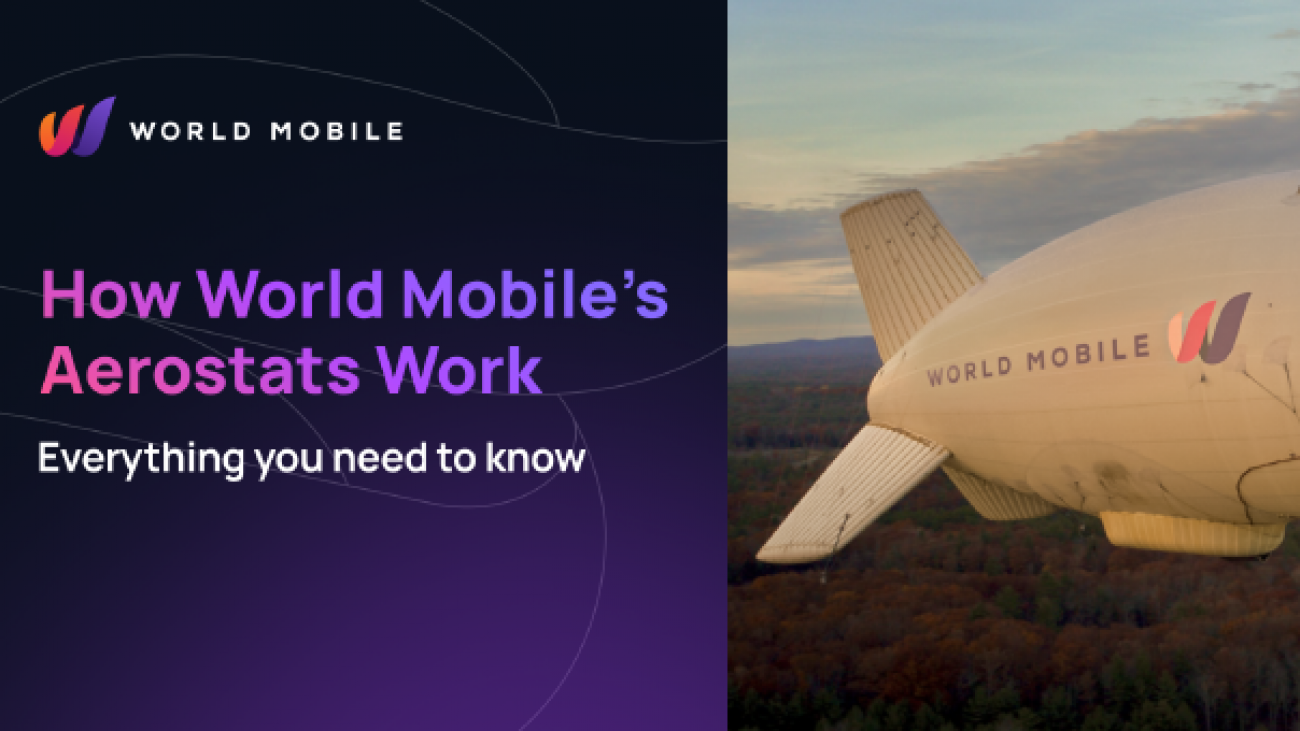How World Mobile’s aerostats work
Thanks to the dynamic design of the World Mobile network, we can deploy connectivity in places legacy mobile operators can’t reach while also delivering decentralised digital identity and creating a sharing economy that allows anyone to benefit and earn from owning a part of the global World Mobile network.
We can reach these remote and previously unconnected areas by adapting the approach and technologies we use to the unique challenges of each region.
One of the technologies that enable our dynamic network is our aerostats. The aerostats World Mobile uses are unpowered balloons that provide connectivity in a wide area and are tethered to the ground with a high-speed fibre connection.
This enables widespread coverage at a fraction of the cost of traditional cell towers, while also allowing for innovative connectivity options and the propagation of our backhaul to AirNode operators wherever we have deployed.
Here is a breakdown of how we use aerostats to connect the unconnected around the world.
What is on our aerostats?
We’ve partnered with aerostat companies like Atlas and Altaeros to provide balloon-based wireless connectivity, beginning with our rollout in Africa.
These aerostat partners deliver lighter-than-air balloons that are loaded with the technology we need to connect people to the World Mobile network and enable AirNode owners to offer and earn from last-mile connectivity in our coverage area.
They act as a telecommunications tower in the sky, optimising coverage while providing backhaul, handset, and IoT connectivity. Aerostats can deliver coverage across a much larger area than traditional cell towers due to their altitude, with our balloons able to provide connectivity in a radius of up to 75km.
The payload – the hardware that provides connectivity and other features – of each aerostat can vary depending on the region we are deploying in, allowing us to tweak each deployment to connect people in the most efficient way possible.
A World Mobile aerostat may feature a payload that includes the following hardware:
- An LTE module that delivers 4G cellular connectivity over licensed spectrum.
- An LTE-U module that enables backhaul over unlicensed spectrum from Wi-Fi AirNodes.
- Sigfox and LoRaWAN modules to connect low-power and battery-powered Internet of Things (IoT) devices.
- An AIS marine tracking module to deliver more efficient tracking of marine vessels in a large radius.
- A fibre tether that bridges the aerostat’s payload and the base station on the ground, linking the balloon to the core of the World Mobile network.
A giant AirNode, backhaul provider, and IoT hub
World Mobile aerostats act as a hub for delivering connectivity over a wide area. They can act as a giant AirNode, providing last-mile connectivity through LTE and LTE-U technology. This means customers can directly connect to the balloon’s payload using their smartphone in the same way they would to a traditional cell tower.
Aerostats can also act as a backhaul provider for AirNode operators in their coverage area. If you own an AirNode in the coverage area of a World Mobile aerostat, you can provide connectivity to users and transmit their data directly to the World Mobile network over a cellular connection to the aerostat, no fibre or fixed-line connection required.
This is enabled by integrated access and backhaul (IAB), which allows the aerostat to both offer standard cellular connectivity and connect AirNodes to the global World Mobile network, allowing them to earn from connecting others even in areas without fixed broadband coverage.
Read more about World Mobile’s dynamic approach to backhaul.
By including IoT modules that use technologies like Sigfox and LoRaWAN on our aerostats, they can function as IoT hubs in the sky. This means World Mobile aerostats can efficiently and cheaply connect a mesh of IoT devices in a large radius, unlocking exciting new opportunities for projects like smart agriculture, smart cities, and environment monitoring.
Similarly, the inclusion of an AIS marine tracking module allows vessels in the range of the aerostat to transmit transponder information via our balloon instead of a satellite, making the communication of vessel locations much cheaper.
Join the unstoppable mobile network
Using balloons to connect the unconnected is just one of the ways World Mobile is disrupting the trillion-dollar telco industry. Our integration of decentralised identity and the sharing economy provides unprecedented opportunity and agency to users on the World Mobile network.
We’ve also turned the traditional mobile network model on its head by allowing users to own parts of our network and earn for providing connectivity to others.
Together, we can connect the billions of unconnected people around the world while allowing everyone to benefit from the shared ownership and growth of our infrastructure.
If you’re interested in finding out more about the World Mobile ecosystem and our mission, check out the links below:
You can also check out CNN’s article – Internet blimps are coming to Zanzibar
